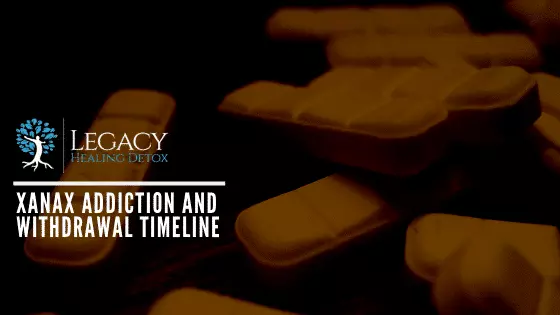Xanax Addiction and Withdrawal Timeline
Xanax is the brand name for a popular anxiety drug, alprazolam. Classified as a benzodiazepine, Xanax is frequently prescribed to treat symptoms of generalized anxiety disorder, panic disorder, and depression. Aside from being a popular pharmaceutical drug, Xanax has a high potential for abuse, causing many people to become addicted to the sedative-like effect that the drug produces. If you or a loved one is suffering from Xanax addiction, you may have many questions about addiction, Xanax withdrawal, detox, and treatment.
Xanax Abuse
Benzodiazepines work by slowing down neurotransmitters that promote feelings of panic, anxiety, and seizures. When these neurotransmitters are slowed down, it makes a person feel relaxed, euphoric, and sometimes drowsy. In addition, when Xanax is abused, it can cause an overflow of dopamine in the brain and trigger the brain’s reward system. When the reward system is triggered, a strong high is produced shortly after consuming the drug. Since Xanax is a short-acting drug, this high goes away quickly. When the high wears off after 2-4 hours, many people experience feelings of depression and anxiety, causing them to take more and more of the drug to sustain a high.
Taken in large doses, Xanax abuse has the potential to lead to respiratory failure, coma, and fatal overdose. Xanax abuse also carries the risk of car accidents, machinery accidents, and serious accidental injury due to decreased reaction time, lack of decision-making abilities, and the lowering of inhibitions.
The effects of Xanax are similar to those of alcohol, and one common way to abuse Xanax is to take it with alcohol because the effects become more pronounced. The euphoria caused by Xanax and the short amount of time it takes for the effects to be felt makes it have a high potential for abuse. If this abuse leads to the development of a psychological and physical dependence on the drug, a Xanax addiction has formed.
Xanax Addiction
If Xanax is abused, the individual may notice that it takes increasingly large quantities of Xanax and more time after consuming the drug in order to feel the euphoric effects it produces. This indicates the development of a tolerance, which can also cause the high to disappear faster than it previously did. If an individual experiences strong cravings for Xanax or withdrawal symptoms, it is likely that he or she is addicted to Xanax.
Some signs of Xanax addiction and abuse include:
- Extreme drowsiness
- Lightheaded or dizzy feeling
- Sleeping more than usual
- Seeming sluggish or intoxicated
- Inability to remember events
- Forgetfulness
- Slurred speech
- Vertigo
- Nausea or vomiting
- Lack of coordination
- Muscle or limb weakness
- Confusion
- Loss of interest in hobbies, work, or other obligations
- Isolating from family and friends
- Running out of medication sooner than the bottle indicates
- Purchasing Xanax illegally on the street
- Impulsivity
- Experiencing Xanax withdrawal symptoms when the drug is not taken
- Using Xanax with other drugs like alcohol or opioids
If you or a loved one are suffering from Xanax addiction, it is important to know that Xanax withdrawal can be dangerous and potentially fatal. It should never be attempted outside of a medical setting.
Xanax Withdrawal Symptoms and Timeline
Severity and symptoms of Xanax withdrawal will vary from person to person depending on a variety of factors. How withdrawals affect a person depends on mental health status, age, weight, metabolism, dosage, and whether or not Xanax is being abused alongside other drugs.
Symptoms of Xanax withdrawal include:
- Depression
- Suicidal thoughts or thoughts of self-harm
- Extreme cravings or compulsions to use the drug
- Confusion
- Hostility and irritability
- Anxious and racing thoughts
- Uncontrollable muscle spasms
- Insomnia
- Poor concentration
- Panic attacks
- Seizures
Depending on the regular dose and how long Xanax has been abused, withdrawal symptoms may begin between 2 and 7 days after taking the last dose. Although Xanax is a short-acting drug, some symptoms of Xanax withdrawal can last between two to eight weeks.
Medical Detox
In order to make the withdrawal process as safe and comfortable as possible, it is important to check into a medical detox. A person who is physically dependent on Xanax should never stop taking the drug cold turkey as this can increase the chances of complications and even death during the withdrawal process. Instead, it is recommended to be slowly tapered off the drug while supervised in a medical setting.
Physical withdrawal symptoms can be dangerous, but the mental obsession that comes with Xanax addiction can be equally as harmful. Despite wanting to quit using Xanax, a person may experience strong cravings and compulsions to use. Individuals who experience this mental anguish during the withdrawal process will benefit from inpatient medical detox where they are supervised around the clock and surrounded by a support system.
Our addiction specialists at Legacy Healing Detox will help make the Xanax withdrawal process as safe and comfortable as possible by providing medication to ease withdrawal symptoms and around-the-clock care.
Drug Rehab
Recovery from Xanax addiction doesn’t stop with detox. For those with a severe Xanax addiction, inpatient drug treatment will be the best option.
Attending a drug rehab can help an individual with Xanax addiction recognize and treat any underlying symptoms or struggles they may have. In addition, therapy and support groups can help foster healthy coping mechanisms to deal with anxiety, panic attacks, and depression. Being armed with these tools will provide individuals with the skills they will need to maintain their sobriety in the long term.
Our therapists work one on one with those who are suffering from addiction and provide them with the best care possible through an individualized treatment program. Give our addiction specialists a call today if you or a loved one is suffering from Xanax addiction to see how we help guide individuals to a path of sobriety.




